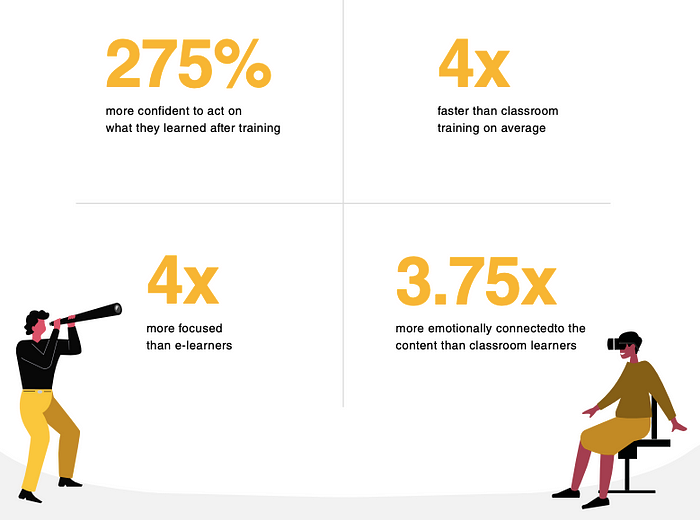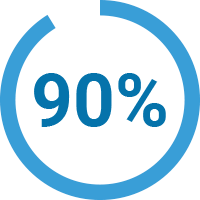VR in Education: What the Data Says
The hype around virtual reality and the Metaverse is all around. We take a look at some of the data and what it says about learning retention.
By Steve Grubbs and Jenny Witt
In the 1920’s and ‘30’s radio in homes swept across the country and around the world. People were amazed that they could receive this information transported invisibly through the air. In the 1940’s and ‘50’s it all changed with the advent of television.

Suddenly, huddling around the radio listening to your favorite program was displaced with not just sound, but a visual as well. The jump from radio to television was dramatic and it changed the world forever.
We are in the midst of the same revolution today, one that — for many — is hiding in plain sight. The age of the Internet has transformed our world in almost every way. This information age made its way into our computers, phones, appliances and cars. That Internet is much like the Age of Radio, because the transition to immersive technologies in virtual reality, augmented reality and the Metaverse, will very quickly sweep this former reality away.

Our focus at VictoryXR for the last six years has been in the area of education and training, a space so ripe for disruption that we are almost certainly headed for a tidal wave of change. So as we charge headlong into this new era of technology, it would behoove us to stop and look at what the data says about its effectiveness.
Learning in virtual reality may seem like a foreign, futuristic concept, but the metaverse is more accessible now than ever. Since the 1960s, virtual reality technology has evolved through various forms, both immersive and non-immersive. The computer game Second Life, popular in the early 2000s, exemplifies an early iteration of non-immersive virtual reality technology made available to consumers. In 2016, companies placed immersive VR headsets on the market for the ordinary consumer for the first time, revolutionizing the field by making immersive virtual reality technology affordable and accessible to people in their homes, schools, and workplaces. HTC Vive and Facebook (now Meta) introduced hardware that began the adoption curve at the consumer level. Now, it’s easier than ever to incorporate VR into the classroom, with the flexibility of teaching either synchronously or asynchronously. Various studies have attempted to measure the efficacy of transitioning from traditional teaching methods to virtual reality immersion in K-12 education. Let’s see what the evidence reveals!
Increased Brain Activity
Virtual reality’s benefits can be directly measured via forms of empirical evidence, like brain scans. Researchers from Saga University in Japan conducted a study in which they used EEGs to measure brain activity in students while learning with VR headsets and compared them with the brain activity of students while learning traditionally. When engaged with learning in a traditional classroom environment, students’ brain activity showed a mere 3.0 increase from their resting state. However, when instead engaged with learning in an immersive VR environment, students’ brain activity increased by a remarkable 15.5 points. Researchers theorized that this significant increase in brain activity among students in virtual reality learning could be attributed to the emotional sensory connection created between students and the learning material, as well as the lack of external distractions while immersed in the virtual environment. Learning in virtual reality therefore alleviates common issues of boredom and distraction among students, allowing them to fully concentrate on their studies.

Focus Increases 4X in PWC Study
Similarly, findings from a VR employee training program developed by PwC in 2020 empirically support the efficacy of learning in virtual reality. Due to the COVID-19 pandemic, PwC implemented virtual reality soft skills training for some of its employees, replacing traditional, in-classroom forms of instruction. When compared with employees that participated in in-person training and online training, VR-trained employees were four times more focused and felt 275 percent more confident to apply the skills they learned after the training ended. Additionally, PwC found that learning in virtual reality enabled training to occur four times faster than training in-person or online, saving companies valuable time and money. Clearly, the benefits of learning in virtual reality are not limited to traditional school subjects, but can be seen across all areas of learning.

A 50% Difference in Pass-rate Among College Students
Additionally, virtual reality has been proven to improve students’ performance on knowledge assessments. In one 2016 study conducted jointly by two Chinese research institutions, researchers taught difficult astrophysics concepts from a typical Chinese high school textbook to two randomly chosen groups of students. One group learned using immersive VR, and the other group learned using traditional teaching methods. After concluding the lessons, researchers administered a test to both test groups to determine how well they retained the learning material. The VR group’s pass rate was an astonishing 90 percent, significantly outperforming the non-VR group, which had a mere 40 percent pass rate. These results show that virtual reality demonstrably has an effect on students’ learning retention.

Likewise, a study conducted by researchers from East Carolina University in 2018 illustrated that students benefit from VR technology when learning STEM concepts. These students learned about biology in two separate conditions. One group of students entered a virtual environment in which they could manipulate strands of DNA, while another group studied DNA through lectures and “serious” educational games. Much like the Chinese study, this study’s results showed that the VR students scored higher than the traditional students on subsequent content tests, revealing the technology’s positive impact. The results from both of these studies clearly demonstrate the concrete performance increases that applying VR technology as a tool in K-12 education can produce.
The positive impacts of VR technology on students’ learning is not confined to STEM fields, although most existing VR-related studies focus on STEM education. Benefits have been demonstrated in nearly all other areas of learning as well, including foreign languages, spatial ability acquisition, and social sciences. In 2018, researchers conducted a study in Spain where they divided high school students in a human geography class into two groups, one that learned using VR headsets and one that learned using tablets. Later, when evaluated on the concepts they learned, the immersive VR students had significantly higher learning gains than the non-VR students. Not only that, but when students from both groups took a concept-retention test one week later, the VR group performed notably better than the non-VR group. This study reveals that using virtual reality technology in education yields visible, lasting performance results, even in non-STEM school subjects.
Medical Students Learning Through VR Analyzed
In contrast, meta-analyses have also proven virtual reality’s efficacy among older students, those enrolled in medical school. A meta-analysis published in the medical journal Annals of Translational Medicine in 2021 evaluated six studies that looked at the performance of VR-educated students as compared to non-VR-educated students. The students involved were at various stages of their medical education, ranging from first-year students up to hospital residents. Medical students are required to learn a vast breadth of difficult information, and traditional methods of learning like lectures and memorization can often be dull and repetitive. In order to overcome this problem, researchers looked at virtual reality as an alternative learning strategy that could enable medical students to actively engage with the material through simulated, hands-on training.
The meta-analysis found that “[Virtual reality] students … express a greater level of confidence in completing the tasks they had been trained to do” and that a statistically significant difference existed in exam pass rates between VR students and non-VR students, with VR students earning higher scores. As demonstrated through these two meta-analyses, virtual reality produces real, quantifiable learning gains across all levels of education, from kindergarten to medical school.
These six studies show that the scientific evidence overwhelmingly supports learning in virtual reality. Research demonstrates that students of all ages that learn with virtual reality are significantly more engaged with the learning material and perform better on learning outcome exams than traditional students, with these gains extending across all subjects. These remarkable gains in academic achievement should not be overlooked. The future of education lies in the metaverse!
Steve Grubbs is the CEO and co-founder of VictoryXR, a company focused on building the education metaverse, particularly metaversities. Steve is the former Chair of the Education Committee in the Iowa House of Representatives.
Jenny Witt is a senior at Boston College studying History and Political Science. She has interned at VictoryXR since August 2021. Outside of the classroom, she enjoys watching movies and exploring Boston with her friends.
